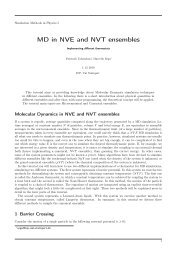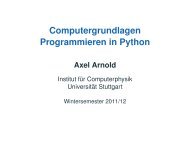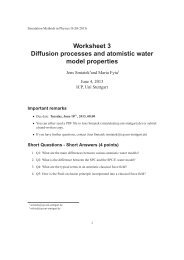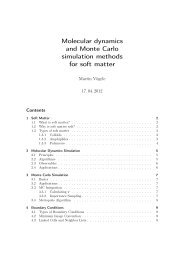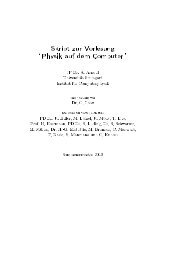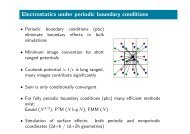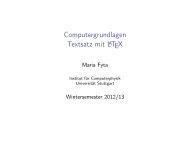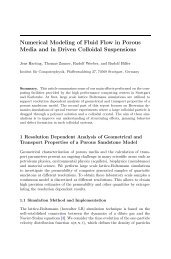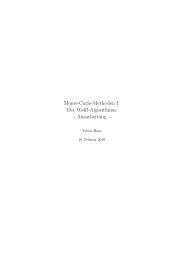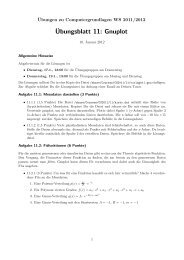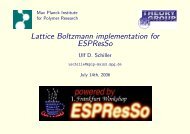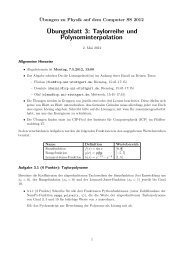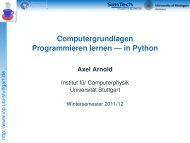Lecture Notes - Institute for Computational Physics - Universität ...
Lecture Notes - Institute for Computational Physics - Universität ...
Lecture Notes - Institute for Computational Physics - Universität ...
Create successful ePaper yourself
Turn your PDF publications into a flip-book with our unique Google optimized e-Paper software.
Simulation Methods II<br />
Maria Fyta - Jens Smiatek<br />
<strong>Institute</strong> <strong>for</strong> <strong>Computational</strong> <strong>Physics</strong><br />
Universität Stuttgart<br />
Apr. 11 2013
Course contents<br />
First principles methods<br />
Hartree-Fock<br />
Density-funtional-theory<br />
Møller-Plesset<br />
Classical Simulations<br />
Molecular Dynamics<br />
Classical <strong>for</strong>ce fields and water models<br />
Coarse-grained models<br />
Hydrodynamic methods<br />
lattice-Boltzmann<br />
Brownian Dynamics<br />
Dissipative Particle Dynamics (DPD)<br />
Stochastic Rotation Dynamics (SRD)<br />
Free energy methods<br />
Overview of multiscale methods<br />
http://www.icp.uni-stuttgart.de M.Fyta 2/25
Course where & when<br />
Thursdays, 11:30-13:00, ICP Seminar room<br />
Exceptions: 02.05<br />
Monday 29.4 at 08:30-10:00 instead.<br />
Tutorials<br />
New worksheets every other week handed out every 2 nd Thursday<br />
Discussion meetings and tutorials; Friday 08:00-10:00 – ICP CIP-Pool<br />
Worksheets due every 2 nd Tuesday.<br />
First discussion meeting (first worksheet): 19.4<br />
First tutorial: 26.4<br />
First worksheet due date: 23.4<br />
Exam<br />
Prerequisite: 50% of the total points in the tutorials<br />
Oral examination at the end of the semester<br />
http://www.icp.uni-stuttgart.de M.Fyta 3/25
Recommended Literature<br />
D. Frenkel and B. Smit, Understanding Molecular Simulation, Academic Press,<br />
San Diego, 2002.<br />
M.P. Allen and D.J. Tildesley, Computer Simulation of Liquids, Ox<strong>for</strong>d Science<br />
Publications, Clarendon Press, Ox<strong>for</strong>d, 1987.<br />
D. C. Rapaport, The Art of Molecular Dynamics Simulation, Cambridge University<br />
Press, 2004.<br />
D. P. Landau and K. Binder, A guide to Monte Carlo Simulations in Statistical<br />
<strong>Physics</strong>, Cambridge, 2005.<br />
M. E. J. Newman and G. T. Barkema, Monte Carlo Methods in Statistical <strong>Physics</strong>.<br />
Ox<strong>for</strong>d University Press, 1999.<br />
J.M. Thijssen, <strong>Computational</strong> <strong>Physics</strong>, Cambridge (2007)<br />
S. Succi, The Lattice Boltzmann Equation <strong>for</strong> Fluid Dynamics and Beyond, Ox<strong>for</strong>d<br />
Science Publ. (2001).<br />
M.E. Tuckermann, Statistical Mechanics: Theory and Moleculr Simulation, Ox<strong>for</strong>d<br />
Graduate Texts (2010).<br />
M.O. Steinhauser, <strong>Computational</strong> Multiscale Modeling of Fluids and Solids,<br />
Springer, (2008).<br />
A. Leach, Molecular Modelling: Principles and Applications, Pearson Education<br />
Ltd. (2001).<br />
R.M. Martin, Electronic Stucture, Basic Theory and Practical Methods,<br />
Cambridge (2004).<br />
E. Kaxiras, Atomic and electronic structure of solids, Cambridge (2003).<br />
http://www.icp.uni-stuttgart.de M.Fyta 4/25
<strong>Computational</strong> <strong>Physics</strong><br />
Bridge theory and experiments<br />
Verify or guide experiments<br />
Involves different spatial and temporal scales<br />
Extraction of a wider range of properties, mechanical, thermodynamic,<br />
optical, electronic, etc...<br />
Accuracy vs. Efficiency!<br />
http://www.icp.uni-stuttgart.de M.Fyta 5/25
http://www.icp.uni-stuttgart.de M.Fyta 6/25
Scales-methods-systems
http://www.icp.uni-stuttgart.de M.Fyta 8/25
Introduction to electronic structure<br />
Source: commons.wikimedia.org<br />
Different properties according to atom type and number, i.e. number of<br />
electrons and their spatial and electronic configurations.<br />
http://www.icp.uni-stuttgart.de M.Fyta 9/25
Electronic configuration<br />
Distribution of electrons in atoms/molecules in atomic/molecular orbitals<br />
Electrons described as moving independently in orbitals in an average<br />
field created by othe orbitals<br />
Electrons jump between configurations through emission/absorption of<br />
a photon<br />
Configurations are described by Slater determinants<br />
Source: Wikipedia<br />
http://www.icp.uni-stuttgart.de M.Fyta 10/25
Electronic shells<br />
Dual nature of electrons: particle and waves BUT “old” electronic shell<br />
concept helps an intuitive understanding of the (double due to spin<br />
up/down) allowed energy states <strong>for</strong> an electron<br />
Source: chemistry.beloit.edu<br />
Ground and excited states<br />
Energy associated with each electron is that of its orbital.<br />
Ground state: The configuration that corresponds to the lowest<br />
electronic energy.<br />
Excited state: Any other configuration.
Pauli exclusion principle<br />
No electron in the same atom can have the same values <strong>for</strong> all four<br />
quantum numbers.<br />
Quantum numbers<br />
principal quantum number n: atomic energy level (n ≥ 1)<br />
azimuthal(angular) quantum number l: subshell, magnitude of angular<br />
momentum (L 2 = 2 l(l + 1), l=0,1,2,...,n-1)<br />
magnetic quantum number m l : specific cloud in subshell, projection of<br />
orbital quantum momentum along specified axis<br />
(L z = m l , − l − l + 1, ..., l − 1, l)<br />
spin projection quantum number m s : spin, projection of spin angular<br />
momentum along specified axis<br />
(S z = m s , m s = −s, −s + 1, ...., s − 1, s)<br />
http://www.icp.uni-stuttgart.de M.Fyta 12/25
Periodic table of the elements<br />
Source: chemistry.about.com<br />
Example <strong>for</strong> Carbon [C] 6 electrons: ground state = 1s 2 2s 2 2p 2<br />
http://www.icp.uni-stuttgart.de M.Fyta 13/25
Bulk vs. finite systems - electronic structure<br />
Source:http://www2.warwick.ac.uk/
Bulk systems (crystalline/non-crystalline materials)<br />
Energy bands, band gap=(valence – conduction) band energy<br />
Band structure (in k-space)<br />
electronic density of states<br />
Example: Carbon, diamond and graphite<br />
[Dadsetani & Pourghazi, Diam. Rel. Mater., 15, 1695 (2006)]
Finite systems - (bio)molecules, clusters<br />
Distinct energy levels<br />
HOMO (highest occupied molecular orbital), LUMO (lowest unoccupied<br />
molecular orbial)<br />
band gap= (HOMO – LUMO) energy<br />
electronic density of states<br />
Example: adamantane<br />
[McIntosh et al, PRB, 70, 045401 (2001)]<br />
http://www.icp.uni-stuttgart.de M.Fyta 16/25
Finite systems - (bio)molecules, clusters<br />
Distinct energy levels<br />
HOMO (highest occupied molecular orbital), LUMO (lowest unoccupied<br />
molecular orbial)<br />
band gap= (HOMO-LUMO) energy<br />
electronic density of states<br />
Example: Adenine-Thymine base-pair in DNA<br />
R.L.Barnett et al, J. Mater. Sci., 42, 8894 (2007)]<br />
http://www.icp.uni-stuttgart.de M.Fyta 17/25
Electronic structure<br />
Probability distribution of electrons in chemical systems<br />
State of motion of electrons in an electrostatic field created by the nuclei<br />
Extraction of wavefunctions and associated energies through the<br />
Schrödinger equation:<br />
i ∂ ∂t Ψ = ĤΨ<br />
time − dependent<br />
EΨ = ĤΨ<br />
time − independent<br />
Solves <strong>for</strong>:<br />
bonding and structure<br />
electronic, magnetic, and optical properties of materials<br />
chemistry and reactions.<br />
http://www.icp.uni-stuttgart.de M.Fyta 18/25
Time-independent molecular Schrödinger equation<br />
( ˆT e + V ee + V ek + ˆT k + V kk )Ψ(r, R) = EΨ(r, R)<br />
r, R: electron, nucleus coordinates<br />
ˆT e , ˆT k : electron, nucleus kinetic energy operator<br />
V ee : electron-electron repulsion<br />
V ek : electron-nuclear attraction<br />
V kk : nuclear-nuclear repulsion<br />
E: total molecular energy<br />
Ψ(r, R): total molecular wavefunction<br />
Born-Oppenheimer approximation<br />
Electrons much faster than nuclei → separate nuclear from electronic<br />
motion<br />
Solve electronic and nuclear Schrödinger equation, Ψ e (r; R) and Ψ k (r)<br />
with Ψ = Ψ k · Ψ e .<br />
http://www.icp.uni-stuttgart.de M.Fyta 19/25
Approximations in electronic structure methods<br />
Common approximations:<br />
in the Hamiltonian, e.g. changing from a wavefunction-based to a<br />
density-based description of the electronic interaction<br />
simplification of the electronic interaction term<br />
in the description of the many-electron wavefunction<br />
Often the electronic wavefunction of a system is expanded in terms of<br />
Slater determinants, as a sum of anti-symmetric electron wavefunctions:<br />
∑<br />
Ψ el (⃗r 1 , s 1 , ⃗r 2 , s 2 , ..., ⃗r N , s N ) =<br />
m 1 ,m 2 ,...,m N<br />
C m1 ,m 2 ,...,m N<br />
|φ m1 (⃗r 1 , s 1 )φ m2 (⃗r 2 , s 2 )...φ mN ( ⃗r N , s N )|<br />
where ⃗r i , s 1 the cartesian coordinates and the spin components. The<br />
components φ mN ( ⃗r N , s N ) are one-electron orbitals.<br />
http://www.icp.uni-stuttgart.de M.Fyta 20/25
Basis-sets<br />
Choices<br />
Bulk systems: plane waves<br />
Molecules/finite systems: atomic-like orbitals<br />
Finite basis set<br />
The smaller the basis, the poorer the representation, i.e. accuracy of<br />
results<br />
The larger the basis, the larger the computational load.<br />
Minimum basis sets:<br />
only atomic orbitals containing all electrons of neutral atom, e.g. <strong>for</strong> H only<br />
s-function, <strong>for</strong> 1 st -row of periodic table, two s-functions (1s and 2s) and one<br />
set of p-functions (2p x , 2p y , 2p z ).<br />
Improvements<br />
double all functions: Double Zeta (DZ) basis<br />
triple all functions: Triple Zeta (TZ) basis<br />
polarization functions (higher angular momentum functions)<br />
mixed basis-sets, contracted basis-sets (3-21G, 6-31G, 6-311G, ...).<br />
http://www.icp.uni-stuttgart.de M.Fyta 21/25
Basis-sets<br />
Plane-waves<br />
Periodic functions<br />
Bloch’s theorem <strong>for</strong> periodic solids: φ mN ( ⃗r N , s N ) = u n,k (⃗r)exp(i ⃗ k ·⃗r)<br />
Periodic u expanded in plane waves with expansion coefficients<br />
depending on the reciprocal lattice vectors:<br />
u n,k (⃗r) =<br />
∑<br />
c nk ( G)exp(i ⃗ G ⃗ ·⃗r)<br />
| G|≤|G ⃗ max<br />
Atomic-like orbitals<br />
φ mN ( ⃗r N , s N ) = ∑ n D nmχ n (⃗r)<br />
Gaussian-type orbitals:<br />
χ ζ,n,l,m (r, θ, φ) = NY l,m (θ, φ)r 2n−2−l exp(−ζr 2 )<br />
χ ζ,lx ,l y ,l z<br />
(x, y, z) = Nx lx y ly z lz exp(−ζr 2 )<br />
the sum l x , l y , l z determines the orbital.<br />
http://www.icp.uni-stuttgart.de M.Fyta 22/25
Common aspects in electronic structure methods<br />
Pseudopotentials<br />
core electrons not considered explicitly (chemically inert); nucleus a<br />
classical point charge<br />
effects of core electrons on valence electrons are replaced by<br />
pseudopotentials<br />
electronic Schrödinger equation solved <strong>for</strong> valence electrons.<br />
Forces<br />
Electrostatic interactions are considered between nuclei and electrons<br />
in electronic structure methods<br />
Hellmann-Feynman theorem<br />
once spatial distribution of electrons obtained through Schrödinger<br />
equation, all <strong>for</strong>ces of the system can be calculated using classical<br />
electrostatics<br />
∫<br />
dE<br />
dλ =<br />
ψ ⋆ (λ) dĤλ<br />
dλ ψ(λ)dτ<br />
http://www.icp.uni-stuttgart.de M.Fyta 23/25
Optimization: wavefunctions and geometries<br />
numerical approximations of the wavefunction by successive iterations<br />
variational principle, convergence by minimizing the total energy:<br />
E ≤ 〈Φ|H|Φ〉<br />
geometry optimization: nuclear <strong>for</strong>ces computed at the end of<br />
wavefunction optimization process<br />
nuclei shifted along direction of computed <strong>for</strong>ces → new<br />
wavefunction(new positions)<br />
process until convergence: final geometry corresponds to global<br />
minimum of potential surface energy<br />
Self consistent field (SCF)<br />
Particles in the mean field created by the other particles<br />
Final field as computed from the charge density is self-consistent with<br />
the assumed initial field<br />
equations almost universally solved through an iterative method.<br />
http://www.icp.uni-stuttgart.de M.Fyta 24/25
ab initio methods<br />
Solve Schrödinger’s equation associated with the Hamiltonian of the<br />
system<br />
ab initio (first-principles): methods which use established laws of<br />
physics and do not include empirical or semi-empirical parameters;<br />
derived directly from theoretical principles, with no inclusion of<br />
experimental data<br />
Popular ab initio methods<br />
Hartree-Fock<br />
Density functional theory<br />
Møller-Plesset perturbation theory<br />
Multi-configurations self consistent field (MCSCF)<br />
Configuration interaction (CI), Multi-reference configuration interaction<br />
Coupled cluster (CC)<br />
Quantum Monte Carlo<br />
Reduced density matrix approaches<br />
http://www.icp.uni-stuttgart.de M.Fyta 25/25



